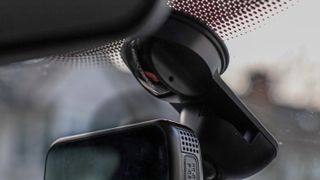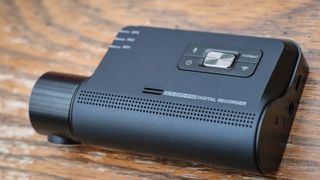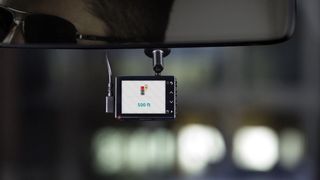The best dash cams have been developed to be about much more than just capturing good quality video, although that should still be your primary consideration when purchasing.
The market has seen huge growth over the last five years, and that has led to global manufacturers entering the market. So, the choices available have become bewildering, with a huge variety of capabilities and a wide range of prices.
Don't worry though as we will explain the main features to look out for when choosing a dash cam.
What is a dash cam?
A dash cam is essentially a small camcorder that attaches inside your windscreen, usually near the rear-view mirror – with some designs even replacing it. Some use suction cups for mounting, allowing them to be removed when not in use, whilst others will be permanently attached via industrial-strength adhesive pads. Some even come with secondary cameras that are meant to be installed inside the rear window pointing backwards.
The main point of a dash cam is that it captures a video of the world around you whilst you are in your car. It’s meant to automatically start recording when you fire up the ignition and stop when you turn your car off. Once you have one installed, you will probably leave it to get on with its job and only refer to the footage in the case of an incident. This could be an accident, or if someone else on the road is driving dangerously and you’d like to report them to the police.
In other words, a dash cam is a safety device to give you peace of mind whilst driving. If something happens, it should have a record you can use as evidence with insurers or the police. It could reveal important identification such as the registration numbers of other vehicles involved. A dash cam could save you money by proving an accident wasn’t your fault, or even save your license. So, it’s a potentially very useful device to have in your car.
How much do dash cams cost?
You can pick up a dash cam for as little as $10, or more than $700. The top models should offer the highest 4K video resolution, a GPS receiver, WiFi smartphone connectivity, and extra security features. However, some very good dash cams can be purchased for less than $200, and there are some that are worth having for under $100, so there’s no need to break the bank to benefit from having this technology in your vehicle.
To help you make an informed buying decision, here are the main features you need to consider when buying a dash cam:

1. Image quality
Some entry-level dash cams record at 720p, but we’d recommend you purchase a model that offers at least 1080p Full HD. Resolution is important with a dash cam, not for aesthetic reasons, but for the practicality of being able to read any text that is captured – particularly a car’s license plate. The top models offer 4K resolution, which has four times as many pixels as 1080p, and there are a number of intermediary options between 1080p and 4K. But resolution isn’t everything, as different levels of compression quality can provide varying results from the same number of pixels. So, make sure you read the reviews and, if available, watch some test footage from the dash cams you’re considering buying (supplied with all our reviews).
2. Field of view
The field of view is the horizontal scope of the camera. The wider the field of view, the more of the scene ahead (or behind with a rear camera) will be captured. This provides greater protection as the camera will catch events further to the side. Most dash cams will offer at least 120 degrees, but some can go as wide as 180 degrees.
3. Night vision and low light conditions
According to the National Highway Traffic Safety Administration, the most dangerous time to drive is the evening rush hour and in the winter when it can be dark. Times of low visibility can also be when drivers don’t see each other. You want your dash cam to deal well with low light conditions, still picking up detail. Some even have specific night modes that automatically change the settings to capture footage in the dark, sometimes in monochrome.
4. Loop recording
Virtually all dash cams have this feature, and if you find one that doesn’t, avoid it. Video files require a lot of storage space – our reviews will note how much footage will fit on a typical memory card capacity. A 4K dash cam might only fit 23 minutes of video on an 8GB card, for example. This would mean that even a regular commute would fill it up, and you wouldn’t want to have to stop to change cards, or indeed have to buy lots of them. Luckily, dash cams have a solution like a lot of security cameras – they record in a loop. This means that once the available capacity is filled, the oldest files will be overwritten by new ones. However, some files can be stored permanently, which we will get to when we discuss Impact Detection later in this feature.
5. Automatic and manual recording
Although the primary function of a dash cam is security, you may also want to make a permanent recording of a scenic route. In this case, it’s important to have the ability to trigger recordings manually, overriding the looping and impact detection.

6. Impact detection
Looping is great for reusing your storage, but you wouldn’t want to get home to find that the moment when another car hit you has been overwritten already. So the vast majority of dash cams have a built-in G-sensor with varying levels of sensitivity that will detect a rapid change of speed in any direction and tag the current video recording as an incident. This takes that clip out of the loop and stores it separately as read only so that it won’t be overwritten. We would argue that, like looping, this is an essential feature in a dash cam.
7. GPS
More expensive dash cams will include a built-in GPS receiver, with a few offering this as an external add-on. This will capture location information alongside the video footage, and may be harnessed for some other functions as well. Although you can set your dash cam to record date and time, the fact that you can set this yourself will make it less than reliable evidence. A dash cam GPS will record an accurate date, time, and location, and can stamp this on the video itself, making the footage much more convincing in a court case.

8. Motion detection/Parking mode
The G-sensor found in many dash cams is often harnessed for motion detection, or it can be provided via camera-based visual motion sensing. When your car is parked, the dash cam can wait in standby mode and fire up when motion is detected. It can then capture people breaking into your vehicle, vandalism, or a collision in a parking lot. This feature sometimes requires a permanent professional installation and hard wiring directly to the car battery, as the cigarette lighter socket will usually be powered down when the car keys aren’t in the ignition, and dash cam battery life is generally quite short.
9. Driver awareness warnings
High-end cars are now coming with extra safety features such as collision detection and alerts when you’re drifting out of your lane on a highway. But, these are usually premium options. Now you can have these features from an add-on dash cam, which uses its camera alongside detection algorithms to provide these facilities. If a dash cam has a GPS receiver, it can provide location-aware warnings as well. These include being loaded with speed limits, and then being set to display these as you drive, as well as letting you know when you’re above the limit. They can also be loaded with red-light and speed camera locations, so they can warn you of these too. However, none of these features is essential to core dash cam duties. They’re just nice to have if you can afford them, and you should always pick the best image quality you want to pay for first, then see if there’s anything left over for these extras.
10. WiFi
Some premium dash cams now integrate WiFi. You can download an app to your smartphone and use that to access the features of the dash cam remotely. This will usually include the ability to change settings and trigger manual recording, but also facilitates downloading recorded clips or posting them on a video sharing website. A few dash cams will even rely entirely on WiFi so that they don’t need an integrated screen, making them less obtrusive.
11. Rear camera options
The main function of a rear-facing camera is to capture what is behind you alongside what’s in front. Most rear dash cams attach to the main front one so that both front and rear footage are stored on the same memory card simultaneously. However, some rear dash cams function as parking cameras, but these will generally entail professional installation so that they are linked to your car directly, enabling the video screen at the front to show the rear when your vehicle is placed in reverse gear. Another recent type of rear-facing camera is one that records the interior of your car, which is useful if you are driving a taxi.
12. Bundled software
Some dash cams come with software to help you view your recordings. This is particularly likely with GPS-enabled dash cams, which can provide a map view that shows your route alongside video playback.


